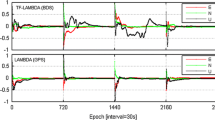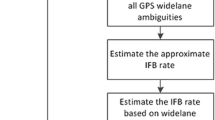Abstract
This paper investigates single epoch ambiguity resolution performance using Galileo four frequency data. Two commonly used ambiguity resolution methods are used in the tests, including the Cascade Ambiguity Resolution (CAR) and the Least-Squares Ambiguity Decorrelation Adjustment (LAMBDA) methods. For CAR method, four optimal combinations are carefully selected according to their wavelength to noise ratios and success rate for ambiguity fixing. The test results show, in general, the LAMBDA method performs better than the CAR method. The speed of ambiguity resolution is closely related to the carrier phase measurement precision. With carrier phase measurement precision of 3 mm, single epoch ambiguity resolution can be achieved at every epoch with simulated 1-s interval 24-h Galileo data (total epochs 86,400). With the increase of carrier phase noise, ambiguity resolution performances become worse. When the noise level is increased to 12 mm, single epoch ambiguity resolution can only be achieved about 50% of epochs.


Similar content being viewed by others
References
Chen W (1992) Fast Ambiguity Resolution with GPS carrier phase measurement. In: Wang G (ed) The collected papers on GPS surveying research and applications. Surveying and Mapping Publishing House, pp 165–174 (in Chinese)
Euler HJ, Schaffrin B (1991) On a measure for the discernibility between different ambiguity solutions in the static-kinematic GPS-mode. IAG symposia No. 107, kinematic systems in geodesy, surveying, and remote sensing. Springer, Heidelberg, pp 285–295
GAL OS SIS ICD/D.0, Galileo open service signal in space interface control document, ref GAL OS SIS ICD/D.0, Issue: Draft, Revision: 0, Date: 23/05/2006
Han S, Rizos C (1996) Integrated methods for instantaneous ambiguity resolution using new generation GPS receivers. In: Proceedings of IEEE PLANS’96, Atlanta GA, pp 254–261
Hatch R, Jung J, Enge P, Pervan B (2000) Civilian GPS: the benefits of three frequencies. GPS Solut 3(4):1–9
Leick A (2004) GPS satellite surveying, 3rd edn. Wiley, New York
Liu JB, Wang ZM (2003) Model of inter-frequency combinations of Galileo GNSS. Wuhan Univ J (Nat Sci) 8(6):723–727
Schlotzer S, Martin S (2005) Performance study of multi carrier ambiguity resolution techniques for Galileo and modernized GPS. In: Proceedings of the institute of navigation’s ION 2005, Long Beach, CA., pp 142–151
Teunissen PJG (1995) The least-squares ambiguity decorrelation adjustment: a method for fast GPS integer ambiguity estimation. J Geod 70(1–2):65–82
Teunissen PJG (1998) Success probability of integer GPS ambiguity rounding and bootstrapping. J Geod 72(10):606–612
Teunissen PJG (2003) An invariant upper bound for the GNSS bootstrapped ambiguity success rate. J Glob Positioning Syst 2(1):13–17
Teunissen PJG (2005) GNSS ambiguity resolution with optimally controlled failure-rate. Artif Satellites 40(4):219–227
Teunissen PJG, Odijk D (1997) Ambiguity dilution of precision: definition, properties and application. In: Proceedings of the institute of navigation’s ION GPS-1997, Kansas City, pp 891–899
Teunissen PJG, Verhagen S (2004) On the foundation of the popular ratio test for GNSS ambiguity resolution. In: Proceedings of ION GNSS-2004, Fairfax, VA, pp 79–88
Tiberius C, Pany T, Eissfeller B, Joosten P, Verhagen S (2002) 0.99999999 confidence ambiguity resolution with GPS and Galileo. GPS Solut 6(2):96–99
Verhagen S (2005) On the reliability of integer ambiguity resolution. J Inst Navigation 52(2):99–109
Vollath U, Birnbach S, Landau H (1998) Analysis of three-carrier ambiguity resolution (TCAR) technique for precise relative positioning in GNSS-2. In: Proceedings of ION GPS-98, Nashville, USA, pp 417–426
Wang ZM, Liu JB, Zhang KF (2004) Multiple carrier ambiguity resolution method for Galileo. The 2004 international symposium on GNSS/GPS, Sydney, Australia, 6–8 December, pp 1–8
Wei M, Schwarz KP (1995) Fast ambiguity resolution using an integer nonlinear programming method. In: Proceedings of ION GPS-1995, Palm Springs CA, pp 1101–1110
Werner W, Winkel J (2003) TCAR and MCAR options with Galileo and GPS. In: Proceedings of ION GPS/GNSS 2003, Portland, Oregon, pp 790–800
Xu GC (2003) GPS theory, algorithms and applications. Springer, Heidelberg
Zhang WT, Cannon ME, Julien O, Alves P (2003) Investigation of combined GPS/Galileo cascading ambiguity resolution schemes. In: Proceedings of ION GPS/GNSS 2003, Portland, USA, pp 2599–2610
Acknowledgments
The work described in this paper was supported by a grant from the Research Grants Council of the Hong Kong Special Administrative Region, China (Project No: PolyU 5158/03E). It was also partially supported by the key Laboratory of Geospatial Informatics of State Bureau of Surveying and Mapping and the National Natural Science Foundation (Grant No. 40504003) of China.
Author information
Authors and Affiliations
Corresponding author
Rights and permissions
About this article
Cite this article
Ji, S., Chen, W., Zhao, C. et al. Single epoch ambiguity resolution for Galileo with the CAR and LAMBDA methods. GPS Solut 11, 259–268 (2007). https://doi.org/10.1007/s10291-007-0057-9
Received:
Accepted:
Published:
Issue Date:
DOI: https://doi.org/10.1007/s10291-007-0057-9




